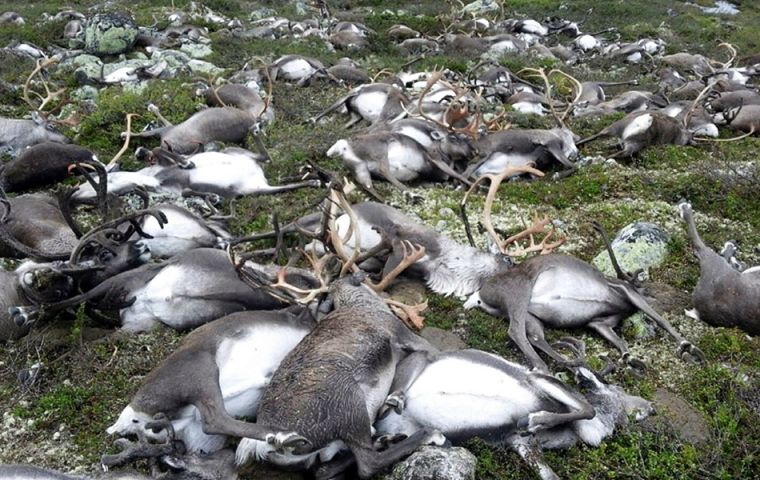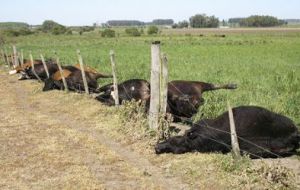MercoPress. South Atlantic News Agency
Lighting kills more than 300 wild reindeers in Norwegian national park
 The Norwegian Environment Agency has released images of reindeer, including 70 calves, that seemingly fell over where they stood in the grasses of Hardangervidda
The Norwegian Environment Agency has released images of reindeer, including 70 calves, that seemingly fell over where they stood in the grasses of Hardangervidda  The national park, the largest in Norway with wild reindeer populations, spans some 8,000 square kilometers and is home to 10,000 to 11,000 wild reindeer.
The national park, the largest in Norway with wild reindeer populations, spans some 8,000 square kilometers and is home to 10,000 to 11,000 wild reindeer.  In 2008, lightning in a San Jose ranch, Uruguay, struck a paddock’s wire fence, killing 52 of the cattle grazing inside.
In 2008, lightning in a San Jose ranch, Uruguay, struck a paddock’s wire fence, killing 52 of the cattle grazing inside. More than 300 wild reindeer were recently killed by lightning at a Norwegian national park, officials say. The Norwegian Environment Agency has released haunting images of reindeer—including 70 calves—that seemingly fell over where they stood in the grasses of Hardangervidda, the largest high mountain plateau in northern Europe.
The national park, the largest in Norway with wild reindeer populations, spans some 8,000 square kilometers and is home to 10,000 to 11,000 wild reindeer.
While specifics on the lightning strike are still unknown at this time, it’s likely that the dead reindeer were a herd that huddled together to weather a severe thunderstorm that rolled through the area on Friday.
It’s not the first time that lightning has caused animal herds to die en masse. In 1990, a thunderstorm killed 30 cattle on a farm in Orange County, Virginia, leaving their bodies scattered in a field. In 2005, a lightning strike killed 68 cows at a dairy farm outside Dorrigo in New South Wales, Australia. And in 2008, lightning in a San Jose ranch, Uruguay, struck a paddock’s wire fence, killing 52 of the cattle grazing inside.
“I’ve heard of groups of cow [getting killed] when it strikes the ground,” says Steve Goodman, a scientist with the National Oceanographic and Atmospheric Administration’s Satellite Service. “The lightning can spread for hundreds and hundreds of meters, for sure”.
However agency spokesperson Kjartan Knutsen said the scale of the wildlife deaths was unprecedented in the country. “We have not heard about such numbers before,” he said.
But Goodman notes that Norway is not particularly prone to severe lightning. Satellite data from NASA’s Global Hydrology Research Center show that in an average year, southern Norway sees fewer than one lightning strike per square kilometer.
In contrast, the world’s biggest lightning hot spot, Venezuela’s Lake Maracaibo, gets struck more than 232 times per square kilometer in an average year—and endures nighttime thunderstorms 297 days of the year.


![“Working directly with President [Donald] Trump and Congress, we accomplished what no one else could,” Patel stressed](/data/cache/noticias/108417/130x80/fbi.jpg)

Top Comments
Disclaimer & comment rulesCommenting for this story is now closed.
If you have a Facebook account, become a fan and comment on our Facebook Page!